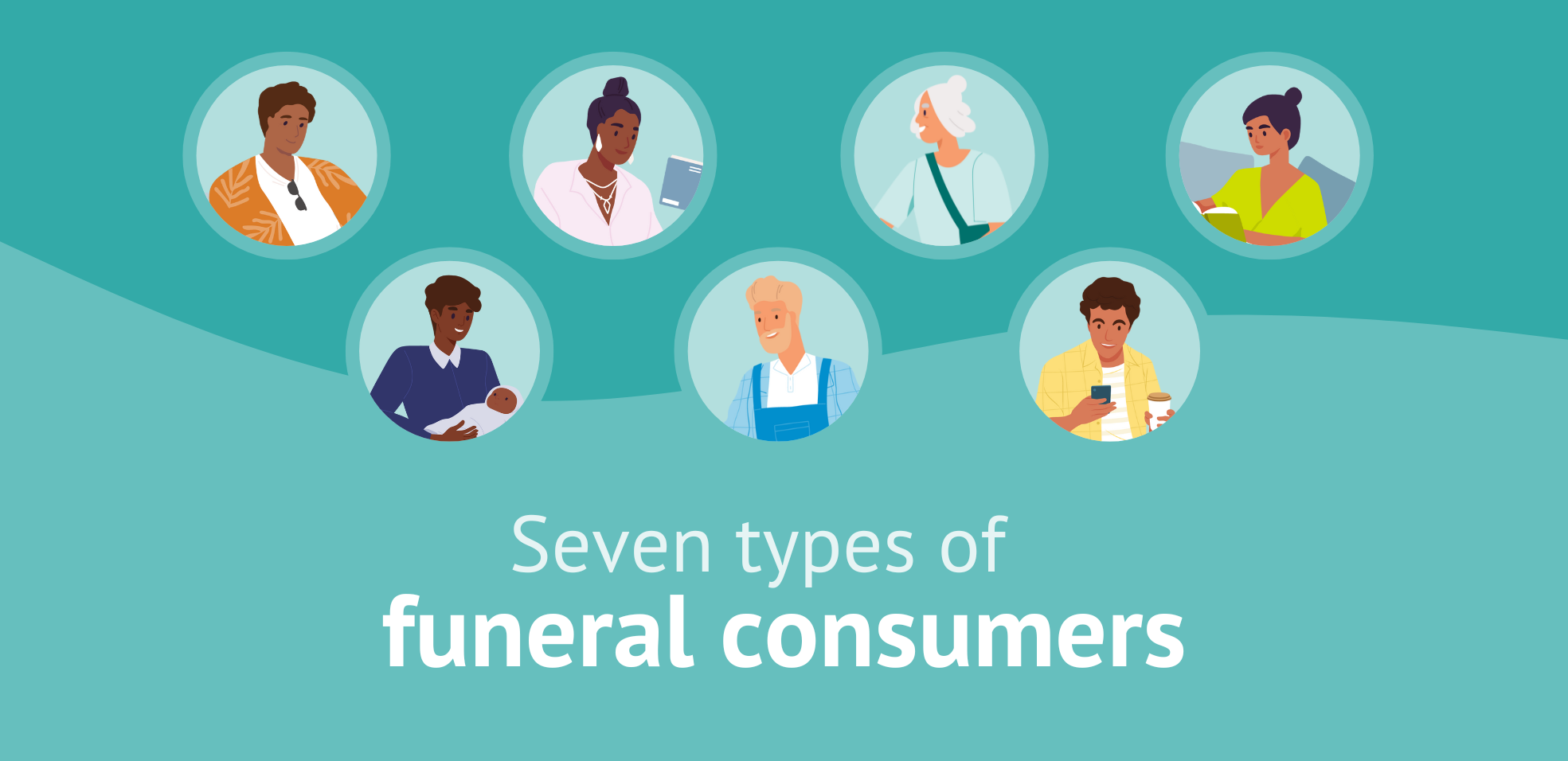4 easy ways to use AI in your funeral home
June 18, 2025

When you think of AI in the funeral home, what do you imagine?
Do you picture a family sitting in an arrangement conference, answering prompts on a computer with no human in sight?
Or maybe you imagine an AI-written obituary filled with inaccurate facts?
If this is how you picture artificial intelligence, then no wonder you’re nervous about using it in your funeral home. However, these are just a few extreme examples that don’t tell the full story.
When used correctly, AI can enhance your service to families and the efficiency of your staff.
AI isn’t here to replace you or take over the funeral profession. It is here to help make your life easier so you can spend more time serving families and trying new ideas!
Do families want to use AI?
If you’re not sure if using AI in your funeral home is the right choice, then consider this. Most families are already willing and open to using AI in their daily lives.
In fact, there are 122.58 million active users on ChatGPT every single day.
Let that sink in.
Perhaps the greater risk comes from not bringing AI to your families.
Think about it – if families already use artificial intelligence for everyday moments, they will likely look for similar options when planning a funeral. It’s now your job to use AI to show families how you can enhance the value of funerals far beyond what they believe is possible.
Episode 4 of The Graveyard Shift podcast discusses AI, its place in funeral planning, and whether families are open to its use. Here’s what Matt Bailey, President and Funeral Director at Bailey Family Funeral Homes, had to say about families' preferences with AI.
“As (AI) becomes more and more available, our families will be using it with or without us. If they’re using it on their own and feeling like they are getting a better product, we have to make sure we’re involved with that process.”
Be ready to adapt and embrace parts of AI, even though trying new methods involves risks.
Gary Freytag, President and CEO of Spring Grove Cemetery, shares why taking risks with new technology can be so tough.
“We are resistant to change because trying something new increases the chances for something to go wrong. There is a lot at stake when wanting to serve a family who is emotionally hurt and grieving.”
But when done well, AI can help give families an even better experience than they thought possible.
By embracing AI in your funeral home, you can work more efficiently, discover new ideas, and better serve families. Here are 4 easy ways to use AI. 👇
#1: Create new ideas for the service
Artificial intelligence is not here to replace you, nor could it.
AI doesn’t have your experience.
AI doesn’t know your community like you do.
AI can’t hug a family or be a shoulder to lean on.
But AI can be a great asset by coming up with new ideas for personalizing a service. Families appreciate when you go the extra mile to create a unique service, and AI can provide a full list of ideas.
When AI creates the list, you can bring those ideas to the family and have meaningful conversations about what elements match the loved one's wishes. Bailey chimes in on the topic.
“AI can give great ideas for the service, and we guide the family from there. We are still the essential element to make the magic happen. AI can generate ideas, but not life experiences.”
The human touch is still the most important element because the funeral director is making the vision come to life for the service. AI can assist and get the ball rolling on what will make for a memorable tribute.
#2: Jump-start an obituary
Writing obituaries takes up a lot of your time. Once you've written a first draft, received edits from the family, and revised a second draft, you've likely spent hours creating a unique obituary.
But what if writing an obituary took just a fraction of that time? Many free AI writing tools can help you create a draft in minutes and quickly make revisions, create alternative drafts, or add more sections to meet a family's request.
By using AI to help with writing the obituary, you can:
-
Provide the family with drafts faster
-
Spend less time on edits
-
Give families multiple options
-
Personalize the obituary with details
-
Strike the right tone
These benefits focus on improving a family’s experience with your funeral home. And since you are part of every step of the process, you can make sure the obituary has the right information and emotion that the loved one would want and the family appreciates. No rogue obituaries here!
Tom Antram, President and CEO of French Funerals & Cremations, talks about AI's huge time-saving elements, especially as it relates to an AI tool for writing obituaries.
“If I can take the information in our platform, hit the AI tool, and print out an obituary that at least gives the family a starting point and a conversation, I saved 20 minutes. And if I can save 20 minutes x 2,000 arrangements a year – holy moly.”
>>>>>Want to know more about Passare’s AI Writing Tool? Check this out.
#3: Prepare talking points
AI will never connect with families better than you can, which is why your role is important during arrangement conferences. Families need to feel heard and supported, and that’s something only you can offer.
However, AI can help you save time preparing for these meetings. Since AI is great at taking in and spitting out information, it can help you create talking points for face-to-face meetings with families.
Imagine AI taking all of the demographic information, hobbies, interests, employment, family ties, etc., and creating a list of questions for you to ask the family to get even more information.
This can help you save time. But more than that, AI’s questions can help you go beyond what you think a family wants and discover what they truly need, even if they don’t know their needs.
Todd Carlson, EVP of Sales and Chief Sales Officer at Directors Investment Group, had this to say.
“What if AI would actually look at the biographical information, their likes, passions, hobbies, occupation, family and friends, where they spend their time, etc., and AI actually creates a list of questions to ask the family about their loved one?”
AI can help you ask the right questions so you can give families exactly what they need to ensure a healing and meaningful grief journey.
#4. Help with the details
We’ve all been in the depths of planning a service and coordinating dozens of last-minute details. With all of the moving parts, wouldn’t it be great if you could outsource a few tasks?
With the help of AI-powered tools, you can now create personalized tribute videos, online guestbooks, and memorial websites that truly reflect the loved ones in your care.
AI can help create meaningful memories celebrating a loved one's life by looking at family and friends' photos, videos, and stories.
Jimmy Lucas, Owner and Funeral Director at Lucas Funeral Homes and Cremations, shares a story about how AI helped, even in a small way.
“We had a husband whose wife had passed away. He wanted her work lanyard removed from her photo, and we had AI remove that for us. Little things like that you can use to help out. But you have to be willing to try.”
Take a few time-consuming, low-stakes tasks off of your plate with the help of AI. That way, you can focus on the things that only you can do.
Be open to change
Remember, technology (no matter how advanced or fancy) doesn’t replace you. It gives you more time to do what you do best – serving families. Lucas says it best:
“This is not about replacing you. It’s about spending more time with families and understanding what families want in the service.”
It’s time to get past the mindset of “that’s the way I’ve always done it” and start pushing your boundaries and funeral service forward.
Antram encourages everyone to embrace the time-saving benefits of AI.
“Get out of our own way, use the tools that are there. Yes, be cautious and don't open AI all the time. But figure out a way to use that technology to promote time savings.”
For more on this topic, check out these episodes on The Graveyard Shift podcast:
Shift #4: Technology, holograms, and Tom Antram
Shift #5: Dead butterflies and AI
Ready to try new technology?
Talk to a tech-savvy team member today.








